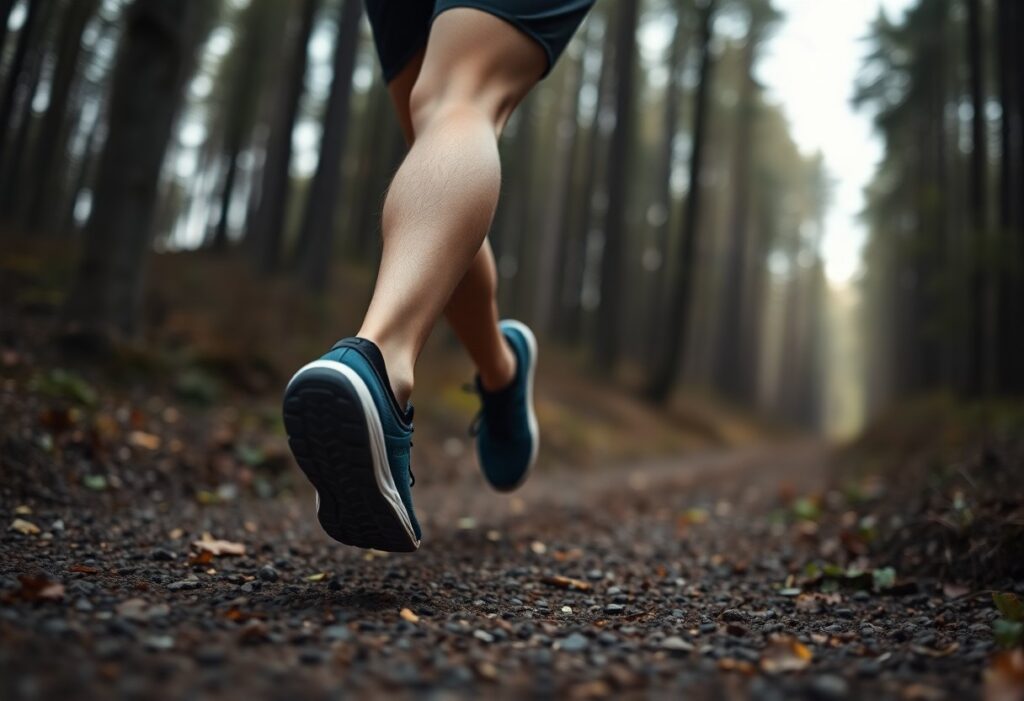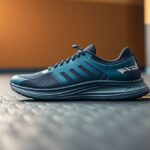
The high injury rates faced by trail runners can be quite concerning, reaching up to a staggering 62% annually. A significant contributor to this issue is the use of inappropriate footwear. To enhance your performance and decrease the likelihood of injuries, it is vital to comprehend the biomechanics involved in utilizing minimalist footwear and how it interacts with uneven terrain. The integration of wearable technology can effectively track essential metrics such as foot strike dynamics and load patterns. Moreover, tailored training programs aim to enhance foot strength and endurance. This article delves into how you can utilize biomechanical insights and cutting-edge technology to develop effective injury prevention strategies.

Maximizing Trail Running Performance with Appropriate Minimalist Footwear Choices
Successfully tackling the diverse and rugged terrain of trail running while wearing minimalist footwear requires more than simply choosing the right shoe; it necessitates a thorough understanding of your individual biomechanics. Failing to recognize the unique challenges posed by different surfaces can significantly heighten your risk of injury. As you navigate various foot strike patterns and descent mechanics, adjusting your technique becomes critical for sustaining optimal performance and minimizing the chances of setbacks.
Exploring Foot Strike Dynamics in Challenging Trail Environments
The dynamics of foot strike can vary greatly when traversing intricate landscapes. Runners who choose minimalist footwear often showcase a remarkable 23% higher incidence of midfoot strikes on uneven trails, compared to a mere 8% noted with traditional running shoes. This adaptation may significantly improve your stability on challenging surfaces; however, it also brings a considerable 37% increase in metatarsophalangeal joint flexion angles, highlighting the necessity of strengthening your foot muscles to boost endurance and lower injury risk.
Evaluating Descent Mechanics and Their Impact on Ground Interaction
The mechanics of descending from elevations play a crucial role in determining your performance and injury risk during trail running. Utilizing minimalist footwear can result in an impressive 42.191 BW/s increase in vertical loading rates on steep 15% declines, especially when compared to flat asphalt surfaces. This increase in loading also leads to heightened lateral toe engagement, which is noted to be 11% greater on loose gravel than on stable surfaces, thus underscoring the greater demands placed on the structural integrity of your feet during descents.
As you navigate technical trails in minimalist shoes, the biomechanics of your feet function in a distinctive manner. The increased vertical loading rates during descents may lead to greater fatigue in your foot muscles, consequently raising your vulnerability to injuries. Additionally, significant changes in toe splay patterns call for improved proprioception and muscle coordination, ensuring your response is effective to the varying terrain below. By concentrating on these aspects, you can adequately equip your body to face the diverse challenges presented by various trails while enhancing your overall running performance.
Understanding the Challenges of Wearable Technology in Trail Running
Although wearable technology has transformed the landscape of trail running, it also introduces substantial challenges in accurately monitoring performance metrics. The variability of terrain conditions, which encompasses steep descents and uneven surfaces, complicates the process of data collection and interpretation. For example, wearable devices frequently struggle to yield consistent vertical oscillation measurements due to changing ground conditions, which may result in misleading insights regarding your gait and running efficiency.
Examining Data Accuracy Variability Among Leading Performance Tracking Devices
Notable discrepancies in data accuracy have surfaced among prominent performance tracking devices. A study conducted in 2024 revealed a 12.4% variance in power measurements on 10% inclines between the Stryd and GARMINRP devices, despite both showing high intra-device reliability (ICC=0.89). Such inconsistencies can create erroneous perceptions regarding your training load and overall performance, potentially hindering your ability to optimize your trail running capabilities.
and GARMINRP devices, despite both showing high intra-device reliability (ICC=0.89). Such inconsistencies can create erroneous perceptions regarding your training load and overall performance, potentially hindering your ability to optimize your trail running capabilities.
The Risks Associated with Miscalculating Training Loads
Miscalculations in training loads can increase by as much as 23% on mixed-terrain routes, directly impacting your injury risk and performance improvement. This issue often arises from inaccurate data interpretations during technical descents or uneven terrains, leading you to rely on potentially flawed metrics. Such discrepancies may cause overtraining or inadequate load management, significantly increasing your chances of sustaining an injury while running.
When navigating complex trail surfaces, the gap between measured and actual exertion can distort your training insights. If your device underreports your exertion, you might inadvertently push beyond your limits, resulting in heightened fatigue and extended recovery periods. Conversely, if your training load is overestimated, you may take a more cautious approach, which could unintentionally stall your performance improvements. Thus, it is vital to ensure that your wearable technology guides rather than misleads your training strategy, thereby preserving both your performance and overall health in the ever-changing environment of trail running.
Investigating Gender Differences in Trail Running Biomechanics
Comprehending the biomechanical distinctions between male and female trail runners can significantly enhance performance while minimizing injury risks. Research indicates that anatomical and physiological variations influence shoe choices, gait patterns, and susceptibility to injuries. Customizing footwear and training programs based on these gender-specific dynamics creates safer and more effective outdoor running experiences.
Examining Gender-Specific Biomechanical Responses Following Exercise
Post-exercise, female runners demonstrate a 19% increase in lateral forefoot pressures compared to their male counterparts after completing 5km barefoot runs. Additionally, they show a 22% reduction in navicular drop during 50km ultra-marathons, indicating that their biomechanical adaptations to trail running are notably distinct. Recognizing these patterns is crucial for enhancing footwear design that accommodates the unique biomechanics of female runners.
Implementing Tailored Solutions for Gender-Specific Performance Enhancement
To effectively address the unique biomechanics of female runners, it is essential to implement customized solutions that consider their specific physical attributes. Tailoring training programs, utilizing gender-appropriate footwear, and enhancing strength regimens can significantly reduce injury rates while improving running performance. For instance, integrating exercises aimed at boosting intrinsic foot muscle endurance and stability can be especially beneficial for women, who may experience different loading patterns on technical terrains.
By analyzing data from various studies and incorporating findings on gender-specific responses, you can better focus on training and footwear that actively support your unique biomechanics. For example, employing targeted strength training regimens that strengthen the lower leg and foot can help your body adapt to the increased demands of trail running, particularly for women who often face heightened pressure in the forefoot area. Selecting shoes specifically designed for your unique foot mechanics can further assist in addressing common injuries, ultimately fostering a more rewarding and sustainable trail running experience.

Harnessing Innovative Techniques for Real-Time Gait Analysis
Your running performance and safety can be greatly enhanced through the application of real-time gait analysis utilizing advanced technological methods. By deploying integrated systems and wearable devices, you gain immediate feedback regarding your foot strike patterns, body mechanics, and overall movement efficiency. These advanced tools are specifically designed to provide actionable insights while you are actively on the trail, empowering you to dynamically adjust your technique and prevent repetitive strain injuries often associated with improper running form.
Recognizing the Impact of Embedded Sensors in Preventing Injuries
Embedded sensors within footwear play a critical role in injury prevention. They continuously monitor your foot strike patterns and pressure distributions in real-time, allowing for immediate corrective feedback. This state-of-the-art technology enables you to pinpoint deviations from optimal running mechanics before they escalate into serious injuries. With an impressive 19-millisecond latency in ground contact alerts, you will receive timely notifications that assist you in maintaining alignment with biomechanical standards essential for avoiding injuries.
Longitudinal Research Demonstrating the Efficacy of Biometric Feedback Technologies
Longitudinal studies highlight substantial improvements in injury rates among trail runners utilizing biometric feedback technologies. Over a six-month period, athletes experienced a 37% reduction in aberrant loading patterns due to consistent monitoring and adjustments informed by real-time data. This robust evidence underscores how ongoing engagement with these technologies can enhance your running economy and resilience, thereby reducing the likelihood of injuries associated with gait abnormalities.
For instance, a comprehensive study involving 250 trail runners documented the effectiveness of wearable sensors in identifying patterns that lead to overuse injuries. Runners who actively engaged with feedback systems reported a 30% lower incident rate of prevalent injuries such as plantar fasciitis and Achilles tendinitis compared to those who relied solely on traditional training methods. The emphasis on continuous tracking, combined with targeted adjustments based on data insights, reflects a shift towards a more proactive approach to injury prevention within the domain of trail running.
Essential Insights on Trail Running Biomechanics and Effective Injury Prevention
In conclusion, understanding the biomechanics of trail running while utilizing minimalist footwear is crucial for optimizing your performance while minimizing the risk of injury. By seamlessly integrating wearable technology and adopting customized training methodologies, you can significantly improve both your foot strength and adaptability to various terrains. Regularly cross-validate metrics from different devices and monitor your gait using advanced tools to effectively personalize your training regimen. This strategy not only supports your running journey but also encourages sustainable practices in your outdoor pursuits.
The Article Trail Running Biomechanics in Minimalist Footwear: Integrating Wearable Technology and Injury Prevention Strategies appeared first on My Shoes Finder
The Article Trail Running Biomechanics: Injury Prevention with Minimalist Shoes Was Found On https://limitsofstrategy.com
The Article Biomechanics of Trail Running: Prevent Injuries with Minimalist Footwear First Appeared ON
: https://ad4sc.com






